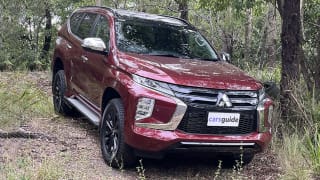These two are evenly matched in terms of drivability and off-road capability.
We spent the lion’s share of our test time off-road but these two vehicles are fine on sealed surfaces; easy to drive (albeit a bit sluggish) and suitably refined (albeit a bit noisy).
Both can feel a tad agricultural to steer about at times but, as I said before, that’s okay and part of the Isuzu charm.
But beyond satisfying any daily-driving requirements these vehicles are impressive 4WDs.
From the engine-and-auto pairing, through to driver-assist tech, physical dimensions and simply general all-round suitability, these two are naturals in most off-road environments.
The D-Max and MU-X have plenty of low- and mid-range torque but both also have quite firm suspension over gravel and dirt tracks at speed, and are rather noisy. Although, if you’ve spent any time in a diesel 4WD the tractable engine’s subdued clatter won’t bother you at all.
But there are some differences between the two in terms of their overall performance off-road.
-
 Isuzu D-Max X-Terrain I Driving
Isuzu D-Max X-Terrain I Driving
-
 Isuzu D-Max X-Terrain I Driving
Isuzu D-Max X-Terrain I Driving
-
 Isuzu D-Max X-Terrain I Driving
Isuzu D-Max X-Terrain I Driving
-
 Isuzu D-Max X-Terrain I Driving
Isuzu D-Max X-Terrain I Driving
-
 Isuzu D-Max X-Terrain I Driving
Isuzu D-Max X-Terrain I Driving
The D-Max has had, through recent development phases, a recalibrated off-road traction control system that's been improved to be more precise and effective through challenging terrain.
But the D-Max now benefits from the introduction of what Isuzu calls Rough Terrain mode, which operates like a boosted off-road traction control, claimed to kick into action at a point of less wheel-spin than a standard off-road traction control system, transferring torque to the wheels that have the most traction, sooner rather than later. Rough Terrain mode debuted in the MU-X in 2021.
This is not a magic pill by itself, but it’s another handy addition to the D-Max’s already-substantial off-road toolbox that also includes a rear diff-lock.
The D-Max has a greater listed ground clearance (240mm) than the MU-X (235mm) but both vehicles have the same wading depth (800mm).
The D-Max is somewhat hamstrung by its longer wheelbase (3125mm compared to the MU-X’s 2855mm wheelbase) and it has shallower approach and departure angles (27.3 and 19.0, respectively) than the MU-X (29.2 and 26.4), but its ramp-over angle is greater (not by much) at 23.8 degrees vs 23.1.
The MU-X is more nimble than the D-Max on technically challenging 4WD tracks, with its shorter wheelbase and shorter overall body length (4850mm vs the D-Max’s 5310mm). Its turning circle is 11.4m compared to the D-Max’s 12.5m.
-
 Isuzu MU-X LS-T 4x4 I Driving
Isuzu MU-X LS-T 4x4 I Driving
-
 Isuzu MU-X LS-T 4x4 I Driving
Isuzu MU-X LS-T 4x4 I Driving
-
 Isuzu MU-X LS-T 4x4 I Driving
Isuzu MU-X LS-T 4x4 I Driving
-
 Isuzu MU-X LS-T 4x4 I Driving
Isuzu MU-X LS-T 4x4 I Driving
-
 Isuzu MU-X LS-T 4x4 I Driving
Isuzu MU-X LS-T 4x4 I Driving
-
 Isuzu MU-X LS-T 4x4 I Driving
Isuzu MU-X LS-T 4x4 I Driving
Those factors don’t take anything away from the D-Max’s efficacy off-road, it simply means this ute needs to be driven with more careful consideration than the wagon.
Often, the size and type of standard tyres on a top-shelf 4WD straight out of a showroom are not ideal for 4WDing and should be replaced if off-roading is on the new owner’s agenda anytime soon.
However, the tyres on this D-Max and MU-X – 265/60R18 Bridgestone Dueler 684II HT (Highway-Terrain) tyres on the D-Max and 265/50R20 Bridgestone Dueler HTs on the MU-X – are okay, but not really up to scratch if tough 4WDing is what you’ll be doing.
The D-Max’s 18-inch wheel-and-tyre package is at least a more 4WDing-friendly sizing than the MU-X’s 20-inch combo.
Replace the HT tyres with a decent set of all-terrain tyres and maybe consider getting rid of the standard suspension while you’re at it and switch in an aftermarket lift kit, just for the hell of it.
Both vehicles have full-sized spares and in terms of packability, the D-Max has a listed payload of 930kg, while payload in the MU-X is 620kg.
Both vehicles can legally tow 750kg (unbraked trailer) and 3500kg (braked).
| | Isuzu D-Max | Isuzu MU-X |
| Score | 8 | 8 |














































